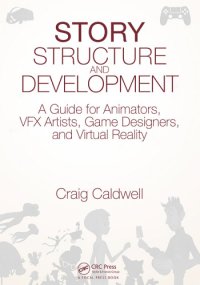
Ebook: Story structure and development: a guide for animators, VFX artists, game designers, and virtual reality
Author: Caldwell Craig
- Tags: Computer animation, Online authorship, Video games--Authorship, Virtual reality, Video games -- Authorship
- Year: 2017
- Publisher: CRC Press
- City: Boca Raton;FL
- Language: English
- epub
Part1. Story structure (the plot) : Plot: the structure : What is a dramatic story? ; Plot ... what is it? : Story elements ; 3 act structure ; Act structures ; Plot: the hero's journey ; Plot structures: the short ; Structure comparisons ; What they all have in common? -- Setup: act 1 : Types of set up : Where to start; Traditional setup sequences ; Opening image(s) ; Exposition ; Show don't tell ; Inciting incident : Types of inciting incidents ; What's at stake? Story world ; Story question -- Middle : Middles ; Types of conflict : Elements of conflict ; Increasing conflict ; Turning points/reversals : Five story turning points ; Cause and effect ; Crisis -- Endings : Ending ; Climax ; Resolution : Deus ex machina ; Meaning -- Story types : Genres ; Story concepts ; Only a few basic plots : Five story goals -- Part 2. Story elements : Story elements : Premise: what is about? ; Theme: what does it mean? ; Emotion : Generating emotion ; Setting -- Story mechanics : What is a scene? : Purpose of a scene; Scene components ; How do scenes work? : Types of scene endings; Scene checklist ; Narrative questions : Types of narrative questions ; Surprise : Techniques for surprise ; Suspense : Technique for suspense ; Comedy ; Subplot ; Foreshadowing: creating anticipation -- Interactive narrative : Why story in games/VR? ; Story versus narrative ; Environmental storytelling ; VR story (telling?) -- Part3. Character development : Character : Character : What are the dramatic qualities of a character? ; Character-driven categories ; Archetypes ; Stereotypes ; Backstory versus character profile : Backstory questions (external) ; Character profile questions (internal) ; Identification/empathy ; Love your characters -- Character elements : Story world as character ; Goal: what a character wants : Goal traits ; Need: what a character really, really wants ; Conflict reveals character ; Choices that a character must make ; Change : Types of change ; Character arc : Types of character arcs ; Character flaws : Types of character flaws -- Character values/motivation : The role of conflict ; Fear: the inner journey ; Unity of opposites ; Creating interesting characters : Character traits -- Part 4. Idea development : Generating ideas : Ideas : Generating story ideas ; Research ; What if? ; Cliché : Cliché problems ; Point of view -- Story development : Development and checklists : Development techniques ; Opposition: antagonism : Memorable villain traits ; Problems at the beginning ; Know your ending : Ingredients to a good ending ; Dialogue: its functions : What kills dialogue ; Subtext : Subtext techniques ; Metaphors and symbols : Making the story ... short -- Viewer (the audience) : The viewer's expectations ; Who knows what? When? : Directing a viewer's attention : A story trick ; Gaps : Internal gaps; External gaps ; Believability ; Coincidences.
Download the book Story structure and development: a guide for animators, VFX artists, game designers, and virtual reality for free or read online
Continue reading on any device:

Last viewed books
Related books
{related-news}
Comments (0)